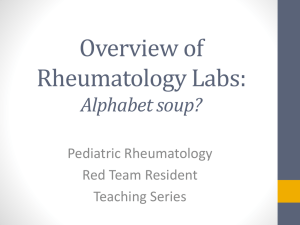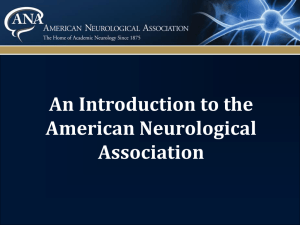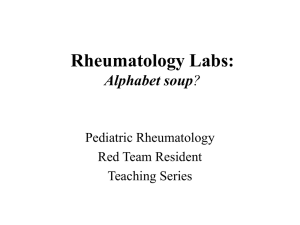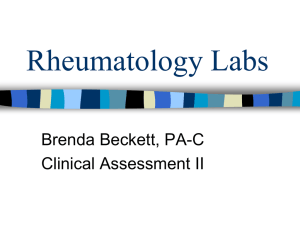clinical significance and detection methods - uni
advertisement
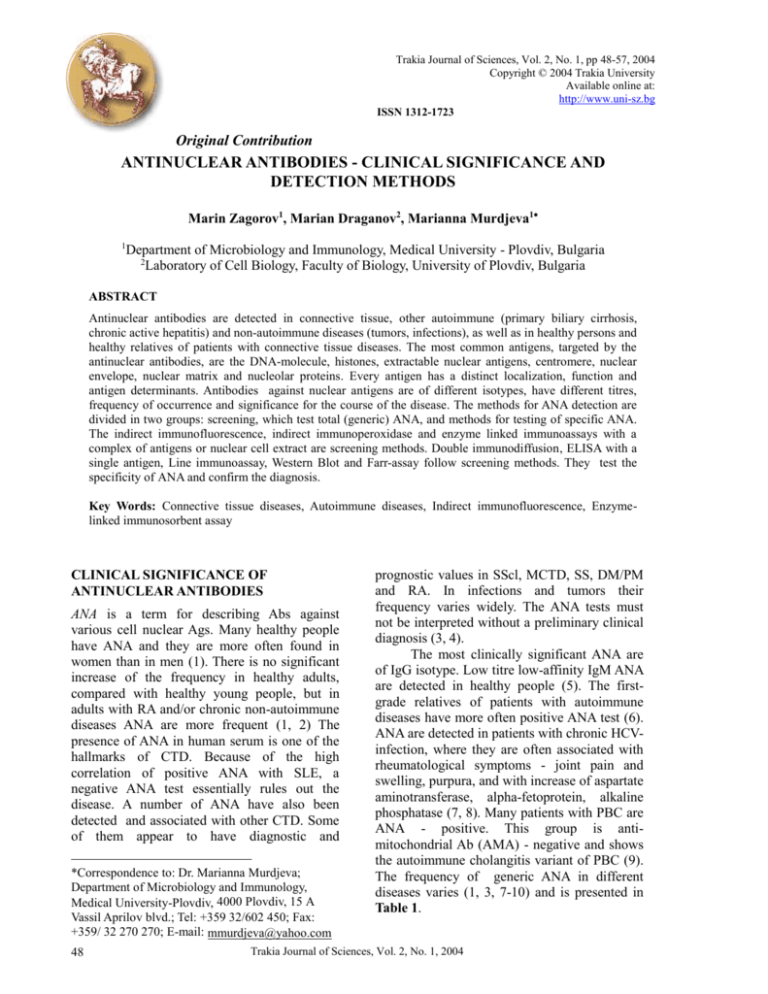
Trakia Journal of Sciences, Vol. 2, No. 1, pp 48-57, 2004 Copyright © 2004 Trakia University Available online at: http://www.uni-sz.bg ISSN 1312-1723 Original Contribution ANTINUCLEAR ANTIBODIES - CLINICAL SIGNIFICANCE AND DETECTION METHODS Marin Zagorov1, Marian Draganov2, Marianna Мurdjeva1 1 Department of Microbiology and Immunology, Medical University - Plovdiv, Bulgaria 2 Laboratory of Cell Biology, Faculty of Biology, University of Plovdiv, Bulgaria АBSTRACT Antinuclear antibodies are detected in connective tissue, other autoimmune (primary biliary cirrhosis, chronic active hepatitis) and non-autoimmune diseases (tumors, infections), as well as in healthy persons and healthy relatives of patients with connective tissue diseases. The most common antigens, targeted by the antinuclear antibodies, are the DNA-molecule, histones, extractable nuclear antigens, centromere, nuclear envelope, nuclear matrix and nucleolar proteins. Every antigen has a distinct localization, function and antigen determinants. Antibodies against nuclear antigens are of different isotypes, have different titres, frequency of occurrence and significance for the course of the disease. The methods for ANA detection are divided in two groups: screening, which test total (generic) ANA, and methods for testing of specific ANA. The indirect immunofluorescence, indirect immunoperoxidase and enzyme linked immunoassays with a complex of antigens or nuclear cell extract are screening methods. Double immunodiffusion, ELISA with a single antigen, Line immunoassay, Western Blot and Farr-assay follow screening methods. They test the specificity of АNA and confirm the diagnosis. Key Words: Connective tissue diseases, Autoimmune diseases, Indirect immunofluorescence, Enzymelinked immunosorbent assay CLINICAL SIGNIFICANCE OF ANTINUCLEAR ANTIBODIES ANA is a term for describing Abs against various cell nuclear Ags. Many healthy people have ANA and they are more often found in women than in men (1). There is no significant increase of the frequency in healthy adults, compared with healthy young people, but in adults with RA and/or chronic non-autoimmune diseases ANA are more frequent (1, 2) The presence of ANA in human serum is one of the hallmarks of CTD. Because of the high correlation of positive ANA with SLE, a negative ANA test essentially rules out the disease. A number of ANA have also been detected and associated with other CTD. Some of them appear to have diagnostic and *Correspondence to: Dr. Marianna Мurdjeva; Department of Microbiology and Immunology, Medical University-Plovdiv, 4000 Plovdiv, 15 А Vassil Aprilov blvd.; Tel: +359 32/602 450; Fax: +359/ 32 270 270; E-mail: mmurdjeva@yahoo.com 48 prognostic values in SScl, MCTD, SS, DM/PM and RA. In infections and tumors their frequency varies widely. The ANA tests must not be interpreted without a preliminary clinical diagnosis (3, 4). The most clinically significant ANA are of IgG isotype. Low titre low-affinity IgM ANA are detected in healthy people (5). The firstgrade relatives of patients with autoimmune diseases have more often positive ANA test (6). ANA are detected in patients with chronic HCVinfection, where they are often associated with rheumatological symptoms - joint pain and swelling, purpura, and with increase of aspartate aminotransferase, alpha-fetoprotein, alkaline phosphatase (7, 8). Many patients with PBC are АNА - positive. This group is antimitochondrial Ab (AMA) - negative and shows the autoimmune cholangitis variant of PBC (9). The frequency of generic ANA in different diseases varies (1, 3, 7-10) and is presented in Table 1. Trakia Journal of Sciences, Vol. 2, No. 1, 2004 ZAGOROV M. et al. The most clinically significant ANA are directed against DNA, histones, CENP, snRNP, Sm, Ro/SS-A, La/SS-B and Scl 70 Ags. The clinical significance of ANA against other nuclear Ags (PM/Scl-overlap-related - against the exosome; PBC–related - against nuclear membrane pore complex, Sp100 and promyelocytic leukemia proteins; RA-related – against heterogeneous nuclear ribonucleoprotein A2; Tu-related - against various tumor-specific nuclear Ags) is still not clear. Table 1. Prevalence of generic ANA in different diseases Disease ANA (%) HW 40 HM 16 SLE 95-100 MCTD, DIL 100 SScl 60-80 For anti-DNA ANA the Ag is dsDNA or ssDNA. High titres of anti-dsDNA Abs are very specific (95% - 99%) for SLE (11, 12). Their presence together with anti-Sm is one of the American College of Rheumatology (ACR) criteria for the diagnosis of SLE (3). The anti-dsDNA level often correlates with the disease activity in SLE and in most patients anti-dsDNA Abs are associated with nephritis (5, 11). High affinity anti-dsDNA Abs might be more relevant to SLE-pathogenesis and to nephritis (5). Low titres of anti-dsDNA Abs occur in healthy persons and in patients with SS, RA and other disorders (11). Anti-ssDNA Abs are commonly detected in SLE patients, their unaffected relatives and other CTD (12). They are not clinically significant (11, 13). For anti-histone ANA the Ag is the nucleosome – a complex, composed of the H2A, H2B, H3, H4 proteins, on which DNA is situated (14). Abs are targeted against distinct proteins and DNA of the nucleosome complex. The DNA-histone complex is much more immunogenic than the molecules alone (4). The anti-histone Abs occur mostly in SLE, DIL, JRA (12). They are not specific for any disease (inclusive DIL), and the correlation to the progression of the disease or to any symptoms is not sure. The ANA-frequency against distinct histones (except anti-H4, which are uncommon) and the frequency of IgG, M and A isotypes in patients with SLE are similar. Drug-induced increase of IgM class is possible, without clinical manifestation (5, 15). Abs against the DNA-histone complex are highly specific for SLE, correlate with the severity of the disease and are associated with lupus nephropathy (16). The anti-centromere ANA are directed against CENPs. The CENP-Ag is built of 7 components: А, В, С, D, E, F, H (17). ACA occur mostly in limited cutaneous form of SScl SS 30-80 DM/PM 70 RA, TD 30-50 PBC 50-70 HCV 12-20 MS 25 (CREST- syndrome) (18,19). Their specificity for the syndrome is 96% (18). ACA are highly associated with sclerodactily, teleangiectasias and calcinosis and with lower pulmonary fibrosis (18, 20). They are less frequent in the other forms of SScl, Raynaud’s syndrome, SLE and RA (11, 21). The presence of ACA against CENP-F is associated with tumors. More than half of the patients with Abs against CENP-F have breast or lung tumors, but anti-CENP-F Abs occur only in 1% of all tumors (22). Other targets for ANA are the extractable nuclear antigens (ENA): Scl 70, SS-A, SS-B, Sm, RNP. The Ag for anti-Scl 70 ANA is a degradation product of topoisomerase 1 - a 70 кD protein, bound on the chromatine. These ANA are detected in SScl, CREST, PM/SScl overlap (19). In SScl they are associated with pulmonary fibrosis and higher rate of mortality (17, 23). In Raynaud’s syndrome anti-Scl 70 ANA have prognostic value for the syndrome progression and the onset of CTD (17). For anti-Ro/SS-A ANA the Ag is a protein, composed of 52 кD molecule, that probably regulates gene expression; 60 кD molecule, bound on RNA; and 46 кD molecule, situated in the endoplasmic reticulum and involved in protein synthesis (24). These molecules differ between species, individuals of one species, and cells of the organism (25). The frequency of ANA, targeted against the different epitopes, varies in different diseases and patients (26). Some epitopes of Ro60 are homologous to the epitopes of vesicular stomatitis virus (27). AntiRo ANA are observed in SS, SLE, RA, JRA and MCTD. The proportion between anti-Ro52 and anti-Ro60 activity varies in different diseases in SLE mainly anti-Ro60 and in SS - anti-Ro52 are found (28, 29). IgG anti-Ro ANA pass through the placenta and cause congenital heart Trakia Journal of Sciences, Vol. 2, No. 1, 2004 49 ZAGOROV M. et al. block and congenital lupus in children born from mothers with SLE (5, 30). For anti-La/SS-B ANA the Ag is a 50 кD protein, associated with the precursors of mRNA, rRNA and tRNA molecules. It binds and transforms them into mature RNA molecules (31, 32). One of the epitope regions of the La/SS-B molecule is homologous to the epitopes of retroviral gag protein (33). Anti-La Abs occur in SS and SLE (4, 34). Their presence in SLE is associated with secondary SS (11). For anti-Sm ANA the Ag is composed of B1,B2,D1-D3,E, F,G proteins and is a part of the spliceosome, which splices the precursor mRNA into the mature form. It is associated with U1-U6 snRNA (35, 36). High-titre IgG anti-Sm ANA are specific for SLE (5, 36), with specificity for the disease 99% (37). Anti-Sm IgM are typical in RA, myasthenia gravis, thyroiditis and MCTD (36). Anti-Sm Abs are found frequently together with anti-RNP ANA. Some authors reveal relationship between high anti-Sm activity in SLE and hemolytic anemia (38). For anti-RNP ANA the Ag is a complex of proteins, associated with Sm in the spliceosome. These ANA exist in the same diseases as antiSm Abs. Their presence in SLE is associated with cutaneous involvement (38). In MCTD the anti-RNP are markers for the diagnosis (4, 5). Anti-Sm and anti-RNP Abs are detected also in patients with tumors, but in this case their clinical significance is unclear (22). The immune response against Sm and RNP in SLE is associated with cytomegalovirus infection (39). The frequency of specific ANA in diseases is different (11, 12, 18-21, 40, 41) and is presented in Table 2. Table 2. Prevalence of specific ANA in different CTD ANA against: SLE dsDNA 75% histones 17-95% CENP 3-10% Scl 70 * Ro/SS-A 25% La/SS-B 9-35% Sm 18-40% snRNP 30-40% *No data available DIL <5% 100% * * * * * * RA * 50-70% 3-10% * 14-24% * 28% * SS <5% * * * 50-80% 40% * * DETECTION METHODS IIFA This method is used for screening of common (generic) ANA. The ANA-Ag complex is visualized with the aid of a fluorescent microscope. It is cheap and easy to perform, but manifests often false positive results in healthy persons. It detects high- and middle-affinity ANA. After ANA screening with IIFA, methods for determination of their specificity are necessary - ELISA, WB or DID (3-5). In ANA IIFA positive samples, the cell nuclei show an apple-green fluorescence with a staining pattern, characteristic of the particular nuclearantigenic distribution within the cells. Its brightness varies from 0 to 4 (+). It is also manifested in various titres of the test-serum. The most frequent pattern is the speckled one (mainly coarse or fine-speckled), followed by a homogenous, nucleolar and centromere 50 SScl <5% * 8-30% 15-75% * * * * CREST MCTD <5% <5% * * 40-85% * 10-12% 13-28% * * * * * * * 100% fluorescence (42). The staining patterns were initially shown by Beck in 1961 (43). The main recently approved staining patterns correlate with specific ANA and are associated with certain diseases (12, 44). This is summarized in Table 3. The substrates, used in IIFA for ANA, are rodent tissue (rat liver) sections and mammalian cell cultures. Cell culture substrates show greater sensitivity than tissue sections. The sensitivity also varies with the fixative procedure and types of ANA, present in the sera. IIFA ANA using the human epithelyoma cell line HEp-2 as a substrate is the preferred method. (3, 5). The advantages of HЕp-2 are: more positive results in CTD patients, due to more mitotically active cells; easy observation and sharper pattern recognition, due to larger size of HEp-2 nucleus; standardized substrate with less Ag variations between the cells; better expression of nuclear Ags, due to their frequent Trakia Journal of Sciences, Vol. 2, No. 1, 2004 ZAGOROV M. et al. division; observation of centromere immunofluorescent pattern (45, 46). The HEp-2 cell line has lower specificity and greater sensitivity, compared to the tissue substrates (3). Table 3. ANA immunofluorescent patterns IIFA PATTERN Homogenous nuclear Nucleolar (homogenous, clumpy or speckled) Speckled (large, coarse or fine) Centromere ANA against dsDNA, ssDNA, histones Disease SLE, low titres in other CTD PM/Scl, Ku, others High titres in SScl, SS SS-A, SS-B, Sm, RNP, Scl 70 CENPs SLE, MCTD, SScl, SS CREST, SScl Screening for anti SS-A ANA on traditional tissue and cell culture substrates is not always reliable. The HEp-2 cells express weakly SSA/Ro Ag and the rodent tissues do not express this Ag at all. The adjustment of the fixation process (e.g. fixing with acetone ) can improve SS-A sensitivity of the substrate (3). Recently a cell line with increased sensitivity for detecting anti-SS-A ANA (HEp-2000) is replacing HEp-2 as a substrate. The HЕр-2000 cells are transfected with Ro60 complementary DNA НЕр-2 cells. They have the ability to hyperexpress the 60 kD SSA/Ro Ag. They are useful to detect and identify the presence of anti-Ro60 Abs, especially in high total ANA-activity sera, where the antiRo60 activity may be hidden.The sensitivity of НЕр-2000 for SS-A-Ro АNA is 77-91% (47, 48). When the Ro/SS-A ANA are the only Abs, present in the serum, they manifest the following patterns: Speckled staining of all interphase cells and stronger staining of the nucleus and/or nucleoli of the hyperexpressing cells. Some cells may show staining in cytoplasm. Staining of the nucleus, nucleoli and possibly the cytoplasm of the hyperexpressing cells. The remaining interphase cells are negative. For all other antibody specificities the HEp2000 cell line exhibits the same staining patterns as HEp-2. Since the nuclear Ags are expressed practically in every cell type, the use of other adherent cell lines as substrates for ANA-IIFA is possible. In our laboratory we use a serum-free cell line, McCoy-Plovdiv, derived from the conventional fibroblast-like McCoy cell line. It was adapted to grow in total absence of serum (49-51) and proved to be a good substrate for ANA detection in IIFA. The ability to detect ANA on serum-free cell lines would result in savings for the laboratories and for the healthcare system. Independently from the IIFA results, it is recommended to perform further tests for specific ANA activity, if clinical signs of CTD are present (52). Crithidia luciliae is another substrate for IIFA. It is non-pathogenic for human haemoflagelate. Its giant mitochondrion (the kinetoplast) contains a dsDNA-molecule. This substrate tests the specific anti-dsDNA activity (53). It is highly specific for the diagnosis of SLE - sensitivity 55-77%, and specificity 8799% (54, 55). Although titres of 1:20 or 1:40 are commonly reported as positive, patients with CTD rarely have these low titres (11). Over 30% of the healthy population have positive ANA test at 1:40. At a titre of 1:80 10-20% of healthy individuals are positive. At a titre of 1:160 5-10% of healthy persons are positive (2, 5, 56). An ANA titre of 1:40 or 1:80 is almost always of minimal significance due to its high prevalence among healthy individuals. Though titres of 1:160 or higher may help confirmation of the diagnosis, false positive results remain common (12). The sensitivity at a titre of 1:40 is 92-95%, but the specificity is low - 60-65%. In 1:160 the specificity of the test is 87-95% and the sensitivity 80-90% (57, 58). A low cutoff point at 1:40 serum dilution (high sensitivity, low specificity) could have diagnostic value, since it would classify virtually all patients with SLE, SScl, or SS as ANA positive. Conversely, a high positive cutoff at 1:160 serum dilution (high specificity, low sensitivity) would be useful to confirm the presence of disease in only a portion of cases, but would be likely to exclude 95% of normal individuals. It is recommended that laboratories performing immunofluorescent ANA tests report results at both 1:40 and 1:160 dilutions Trakia Journal of Sciences, Vol. 2, No. 1, 2004 51 ZAGOROV M. et al. (56) and should supply information on the percentage of normal individuals who are positive at these dilutions (3,56) The absence of ANA at titres of 1:160 or less makes SLE diagnosis very unlike (5). According to the usefulness of ANA test for their diagnosis, the diseases are divided in 5 groups (3): DIL, autoimmune liver diseases, MCTD ANA test is an intrinsic part of the diagnostic criteria; SLE, SScl - ANA test is very useful; SS, DM/PM - ANA test is somewhat useful; JRA, Raynaud’s syndrome - ANA test is useful for monitoring and prognosis; RA, MS, TD, discoid lupus, infectious diseases, tumors - ANA test is not useful. An improved tool for observation of IIFAimages is the confocal microscope. It allows observation of high-definition directly digitized images and has a possibility for 3-dimensional light scanning of the object (59). IIPА It is a screening method, similar to IIFA. The substrates (tissue sections, cell cultures, Crithidia luciliae) are the same. The image types are similar to those obtained by IIFA. In IIPА the result is observed by means of a standard light microscope and can be preserved for a long time without any change (60). The sensitivity of IIPA is almost equal to this of IIFA. The comparison of both methods on HEp2 substrate shows equal results (positive and negative) in 97% of the cases and the nuclear patterns are similar in 87% (61). The same results are observed on Crithidia luciliae: there is no difference in the titres of test sera detected by both methods. The correlation between their sensitivity (IIFA/IIPA) is 1/0,98, and between their specificity - 1/0,99 (60). Farr-assay It is a radioimmune assay that detects antidsDNA activity. The substrate is the DNA molecule, labeled with an iodine radioactive isotope (J125). The activity of anti-dsDNA ANA is determined by measurement of the radioactivity of labeled dsDNA - anti-dsDNA complexes (62). The method has a high specificity for dsDNA ANA (85%) and 64% sensitivity (55). In contrast to ELISA it detects high-affinity ANA (5). 52 DID This is an Ouchterlony test for ENA with a nuclear extract from thymus or spleen cells.This method is used to detect specific ANA in sera that are positive on screening. It determines high-affinity ANA (4, 5). The ANA concentration is defined by the precipitation band. The method is slower and less sensitive than enzyme immunoassays (42). ELISA This method can detect common (generic) ANA with a substrate of cell nuclei, nuclear extract or mixture of Ags - purified, recombinant, obtained from in vitro transcribed DNA, or detects specific ANA with a single-Ag substrate (dsDNA, RNP, Sm, SS-A/Ro, SS-B/La, CENP, Scl70) - purified or recombinant. As the method detects low-affinity ANA it shows frequent false positive results (3-5). The АNA activity in the serum is defined by the index Y, derived from the colorimetric measured optical density of the sample (3).The sensitivity and specificity of ELISA depend on the cut/off value of Y, above which the test is considered ANA-positive. For screening test cut/off value 1 is used in cases, where high diagnostic sensitivity is necessary, to avoid the misdiagnosis of possible CTD. In weak positive sera (1<Y<3) a secondary test is performed, when clinical suspicion of CTD exists. A large number of patients with diseases, different from CTD, have an index Y < 3 (88%). More than 75% of the patients with CTD have Y >3. The PPV of the cutoff >3 for CTD is >85%, and the sensitivity is 92%. At cutoff >6 PPV is >94% and the test is high-specific for the diagnosis of CTD (58). A variant of ELISA is the LineImmunoassay. In this method the Ags are fixed on nylon strips. The assay can test single samples and the results can be stored for a long time (37, 42). IIFA is the traditional method of choice for ANA-screening. In some laboratories it is replaced by screening- ELISA. The advantages and the disadvantages of both ANA screening methods are discussed extensively (5,37,45,47,57,58,63,64) and are presented in Table 4. Trakia Journal of Sciences, Vol. 2, No. 1, 2004 Table 4. IIFA and ELISA - advantages and disadvantages METHOD Advantages IIFA ELISA Disadvantages High-sensitive Easy to perform Detects high- and middle- affinity ANA Detects low-affinity ANA Objective, automated, detects many samples at the same time Specificity and sensitivity vary with the variation of the cut/off value Semi-quantitative results Subjective Uneasy to detect many samples Requires fluorescent microscope ENAs may be lost during preparation More often false (+) results in healthy subjects More often false (-) results in children Differences between sensitivity/specificity of the distinct ELISA kits It is not well established what mix of Ags should be used - from natural source (HEp-2) or recombinant WB This test is used to define specific АNA after positive IIFA or ELISA-screening. The substrates are НЕр-2 or rabbit thymus cells. They are separated on two-dimensional polyacrylamide-gel electrophoresis and transferred onto a nitrocellulose membrane. The result of the test is in the form of lines and every line corresponds to an Ag, to which a specific Ab from the serum is bound. The lines are compared to referent plates. When HЕp-2 cell substrate is used and sera from patients with SLE are tested, the Ag zone between 21 and 48кD, which has a diagnostic value for SLE, is positive. Possible specific positive zones in CREST syndrome are the 18-22 кD and in SScl the 30, 32, 73, 80 кD regions (65, 66). Microparticle-based analysis of ANA by flow cytometry This immunological assay has a big potential in ANA-detection. It is a bead based flow cytometry that can detect and quantitate ANA. There are two variants of this assay. In the first, the tested ANA is bound on the bead through a capture specific Ag and later the anti-analyte Ab binds on the complex, acting as the reporter molecule. In the second, the beads are coupled with a purified ANA, the same as the tested one. The ANA on the bead and in the test-sample compete the binding to the fluorescent reporter Ab. In this case, the presence of ANA in the test-sample results in fluorescence inhibition. The flow cytometric detection of ANA is rapid, automated and gives quantitative results. The sensitivity and specificity of the test are nearly 100% and it detects many specific ANA in one sample simultaneously (67). DIAGNOSTIC ALGORITHMS FOR ANA There are some contradictions within the area of ANA detection, arising when the results of different laboratories (using different methods of detection) are compared. This leads to the question about the choice of a method for ANA screening and their further detection. There are algorithms (3), designed to give the laboratory a comprehensive guide to pattern recognition, Ag specificity and disease association. A model algorithm is presented in Figure 1. CONCLUDING REMARKS Test results for ANA alone are insufficient to establish the diagnosis and they must always be interpreted in the context of patients’ history and symptoms. The positive results may mean all sorts of things and can be misleading, so that the clinicians must have good clinical reasons for requesting ANA test. The cooperation with the clinical immunologists, possessing experience with the methods, used for ANAdetection, and with a knowledge about the differences between these methods, is of great importance. ABBREVIATIONS Ab(s) – antibody(ies); ACA - anticentromere antibodies; Ag(s) – antigen(s); ANA antinuclear antibodies; CENP(s) - centromere protein(s); CTD - connective tissue disease; Dg - diagnosis; DID - double immunodiffusion; DIL - drug-induced lupus; DM dermatomyositis; dsDNA - double-stranded DNA; ssDNA - single-stranded DNA; ELISA enzyme-linked immunosorbent assay; HCV hepatitis C virus; HEp-2 – human epithelyoma ZAGOROV M. et al. cell line; HM - healthy men; HW - healthy women; IIFA - indirect immunofluorescence assay; IIPA - indirect immunoperoxidase assay; JRA - juvenile rheumatoid arthritis; MCTD mixed connective tissue disease; MS - multiple sclerosis; PBC - primary biliary cirrhosis; PM polymyositis; PPV - positive predictive value; RA - rheumatoid arthritis; rRNA - ribosomal RNA; tRNA - transfer RNA; mRNA messenger RNA; snRNA - small nuclear RNA; snRNP - small nuclear ribonucleoprotein; Sm Smith-antigen; SScl - systemic sclerosis; SS - Sjogren's syndrome; TD - thyroid disease; Tu tumors; WB - Western blot. REFERENCES Nuclear Antigens. Arch Pathol Lab Med,124:71–81, 2000. 4. Fritzler, M., Autoantibodies: Diagnostic fingerprints and etiologic perplexities. Clin Invest Med, 20 (1):55-66, 1997. 5. Egner, W., The use of laboratory tests in the diagnosis of SLE. J Clin Pathol, 53(6):424432, 2000. 6. Corporaal, S., Bijl M., Kallenberg C., Familial Occurrence of Autoimmune Diseases and Autoantibodies in a Caucasian 1. Juby, A., Davis, P., Prevalence and disease associations of certain autoantibodies in elderly patients.Clin Invest Med, 21(1):4-11, 1998. 2. Teubner, A., Tillmann, H., Schuppan, D.,et al., Prävalenz von zirkulierenden Autoantikörpern bei gesunden Individuen. Med Klin, 97:645–649, 2002. 3. Kavanaugh, A., Tomar, R.., Reveille, J., Guidelines for Clinical Use of the ANA Test and Tests for Specific Autoantibodies to 54 ACKNOWLEDGMENTS This study was enabled by a grant awarded for a research project (No 05/2003) of the Medical University – Plovdiv. Trakia Journal of Sciences, Vol. 2, No. 1, 2004 ZAGOROV M. et al. 7. 8. 9. 10. 11. 12. 13. 14. 15. 16. 17. 18. 19. 20. Population of Patients with SLE. Clin Rheumatol, 21:108–113,2002. Agarwal, N., Handa, R., Acharya, S., et al. A study of autoimmune markers in hepatitis C infection. Indian J Med Res,113:170-174, 2001. Peng ,Y., Hsieh, S., Yang, D., et al. Expression and clinical significance of antinuclear antibodies in hepatitis C virus infection. J Clin Gastroenterol, 33(5):402406, 2001. Jones, D., Autoantigens in primary biliary cirrhosis. J Clin Pathol, 53(11):813, 2000 Bozhkov, B., Popova, D., Autoimmunity and autoimmune diseases. "ARSO" Medical Publishing Company, Sofia, Bulgaria, 1997. Lane S., Gravel J., Clinical utility of common serum rheumatologic tests. Am Fam Physician, 65(6):1073-1080, 2002. Nelson, M., Heffernan, M., Synopsis of antinuclear antibodies in dermatology. Dermatology Nursing, 14(3):165-169, 2002. Stites, D., Terr, A., Parslow, T., Basic & Clinical Immunology: 8th edition, Appleton & Lange, East Norwalk, Conn, USA, 1994. Becker, W., Deamer, D., The world of the Cell: 2nd edition, The Benjamin/Cummins Publishing Company, Inc., New York, NY, USA, 1991. Cohen, M., Pollard, K., Webb, J., Antibodies to histones in systemic lupus erythematosus: prevalence, specificity, and relationship to clinical and laboratory features. Ann Rheum Dis, 51(1):61-66, 1992. Cervera, R., Viñas,O., Ramos-Casals, M., Anti-chromatin antibodies in systemic lupus erythematosus: a useful marker for lupus nephropathy. Ann Rheum Dis, 62:431–434, 2003. Ho, K., Reveille, J., The clinical relevance of autoantibodies in scleroderma. Arthritis Res Ther, 5(2):80-93, 2003. Steen, V., Powell, D., Medsger, T., Clinical correlations and prognosis based on serum autoantibodies in patients with systemic sclerosis. Arthritis Rheum, 31(2):196-203, 1988. Jarzabek-Chorzelska, M., Blaszczyk, M., Jablonska, S., et al. Scl 70 antibody-a specific marker of systemic sclerosis. Br J Dermatol, 115(4):393-401, 1986. Steen, V., Ziegler, G., Rodnan, G., Medsger, T., Clinical and laboratory associations of anticentromere antibody in patients with 21. 22. 23. 24. 25. 26. 27. 28. 29. 30. 31. progressive systemic sclerosis. Arthritis Rheum, 27(2):125-131, 1984. Russo, K., Hoch, S., Dima, C., et al. Circulating anticentromere CENP-A and CENP-B antibodies in patients with diffuse and limited systemic sclerosis, SLE and RA. J Rheumatol, 27(1):142-148, 2000. Abu-Shakra, M., D Buskila, D., Ehrenfeld M., et al. Cancer and autoimmunity: Autoimmune and rheumatic features in patients with malignancies. Ann Rheum Dis, 60(5):433-441, 2001. Hesselstrand, R., Scheja, A., Shen, G., et al. The association of antinuclear antibodies with organ involvement and survival in systemic sclerosis. Rheumatology (Oxford), 42(4):534-540, 2003. McCauliffe, D., Sontheimer, R., Molecular characterization of the Ro/SS-A autoantigens. J Invest Dermatol, 100(1):7379, 1993. Frank, M., Itoh, K., McCubin, V., Epitope mapping of the 52 kD Ro/SS-A Autoantigen. Clin Exp. Immunol., 95:390396, 1994. Ricchiuti, V., Briand, J., Meyer, O., et al. Epitope mapping with synthetic peptides of 52-kD SSA/Ro protein reveals heterogeneous antibody profiles in human autoimmune sera.Clin Exp Immunol,95(3):397- 407,1994. Scofield, R., Harley, J., Autoantigenicity of Ro/SSA antigen is related to a nucleocapsid protein of vesicular stomatitis virus. Proc Natl Acad Sci U S A. 88(8):3343-3347, 1994. Ben-Chetrit, E., Fox, R., Tan, E., Dissociation of immune responses to the SS-A (Ro) 52-kd and 60-kd polypeptides in SLE and Sjogren's syndrome. Arthritis Rheum,33(3):349-355, 1990. Slobbe, R., Pruijn, G., Damen, W., Detection and occurrence of the 60- and 52kD Ro (SS-A) antigens and of autoantibodies against these proteins. Clin Exp Immunol, 86(1):99-105, 1991. Buyon, J., Ben-Chetrit, E., Karp, S., et al. Acquired congenital heart block. Pattern of maternal antibody response to biochemically defined antigens of the SSA/Ro-SSB/La system in neonatal lupus. Clin Invest., 84(2):627-634, 1989. Rinke, J., Steitz, J., Precursor molecules of both human 5S ribosomal RNA and transfer RNAs are bound by a cellular protein Trakia Journal of Sciences, Vol. 2, No. 1, 2004 55 ZAGOROV M. et al. 32. 33. 34. 35. 36. 37. 38. 39. 40. 41. 42. 56 reactive with anti-La lupus antibodies. Cell, 29(1):149-159, 1982. Steitz, J., Berg, C., Hendrick J., et al. A 5S rRNA/L5 complex is a precursor to ribosome assembly in mammalian cells. J Cell Biol, 106(3):545-556, 1988. Kohsaka, H.,Yamamoto, K., Fujii, H., Fine epitope mapping of the human SS-B/La protein. Identification of a distinct autoepitope homologous to a viral gag polyprotein. J Clin Invest, 85(5):1566-1574, 1990. Olhoffer, I., Peng, S., Craft, J., Revisiting autoantibody profiles in systemic lupus erythematosus.J Rheumatol, 24(2):297-302, 1997. Seraphin, B., Sm and Sm-like proteins belong to a large family: identification of proteins of the U6 as well as the U1, U2, U4 and U5 snRNPs. EMBO J, 14(9):20892098,1995. Abu-Shakra, M., Krup, M., Slor, H., Shoenfeld, Y., Anti-Sm-RNP activity in sera of patients with rheumatic and autoimmune diseases. Clin Rheumatol, 9(3):346-355, 1990. Maclachlan, D., Vogt, P., Wu, X., et al. Comparison between line immunoassay (LIA) and ELISA for the determination of antibodies to extractable nuclear antigenes (ENA) with reference to other laboratory results and clinical features. Z Rheumatol, 61(5):534-544, 2002. Meyer, O., Bourgeois, P., Aeschlimann, A., Immunoblotting profiles in 55 SLE sera lacking precipitating antibodies to extractable nuclear antigens. Ann Rheum Dis, 48:594-599, 1989. Newkirk, M., Venrooij, W., Marshall, G., Autoimmune response to U1 small nuclear ribonucleoprotein (U1snRNP) associated with cytomegalovirus infection. Arthritis Res, 3:253–258, 2001. Catoggio, L., Skinner, R., Maddison, P., Frequency and clinical significance of anticentromere and anti Scl-70 antibodies in an English connective tissue disease population. Rheumatol Int., 3(1):19-21, 1983. Brasington, R., Kahl, L., Ranganathan, P., et al. Immunologic Rheumatic Disorders. J Allergy Clin Immunol, 111(2):593-596, 2003. Peene, I., Meheus, L., Veys, E., et al.Detection and identification of 43. 44. 45. 46. 47. 48. 49. 50. 51. 52. 53. antinuclear antibodies in a large and consecutive cohort of serum samples referred for ANA testing. Ann Rheum Dis, 60(12):1131-1136, 2001. Beck, J., Variations in the morphological patterns of autoimmune nuclear fluorescence. The Lancet, 1:12031205,1961. Calvin, R., Bhan, A., McCluskey, R., Diagnostic Immunopathology: 2nd. Edition. Raven Press, New York, NY, 1995. Kern, P., Kron, M., Hiesche, K., Measurement of Antinuclear antibodies: Assessment of Different Test Systems. Clin Diagn Lab Immunol, 7(1):72-78, 2000. Prost, A., Abuaf, N., Roquette-Gally, A., et al. Comparing HEp2 cell line with rat liver in routine screening test for ANA in autoimmune diseases. Ann Biol Clin, 45:610-617, 1987. Van Ael, W., Vandenbossche, M., Vervaet, T., et al. Sensitivity of the HEp-2000 Substrate for the Detection of AntiSSA/Ro60 Antibodies, Clin Rheumatol, 19:291–295, 2000. Pollock, W., Toh, B-H., Routine immunofluorescence detection of Ro/SS-A autoantibody using HEp-2 cells, transfected with human 60 kDa Ro/SS-A. J Clin Pathol, 52:684–687, 1999. Draganov, M., Murdjeva, M., Kamberov, M., Development of a new serum-free cell culture system, McCoy-Plovdiv. In vitro Cell Dev. Biol.-Animal, 36:284-286, 2000. Draganov, M., Murdjeva, M., Popov, N., Study on proliferative activity and chromosome contents of serum-free cell culture McCoy-Plovdiv. Comptes rendus de l'Academie bulgare de Sciences, 54(9):9598, 2001. Draganov, M., Murdjeva , M., Study on cell morphology, dynamics, monolayer formation and post-confluent state of McCoy-Plovdiv - a serum-free cell line. Trav. Sci.Univ. Plovdiv, Microbiologia et Cytologia. 39(6):31-43, 2003. Hoffman, I., Peene, I., Veys, E., et al., Detection of specific antinuclear reactivities in patients with negative anti-nuclear antibody IF screening tests. Clin Chem, 48(12):2171-2176, 2002. Aarden, L., de Groot, E., Feltkamp, T., Immunology of DNA: Crithidia luciliae, a simple substrate for the determination of Trakia Journal of Sciences, Vol. 2, No. 1, 2004 ZAGOROV M. et al. 54. 55. 56. 57. 58. 59. 60. anti-dsDNA with the IF technique. Ann N Y Acad Sci, 254:505-515, 1975. Villalta, D., Bizzaro, N., Corazza, D., Evaluation of a new automated enzyme fluoroimmunoassay using recombinant plasmid dsDNA for the detection of antidsDNA antibodies in SLE. J Clin Lab Anal, 16(5):227-232, 2002. Borda-Iriarte, O., Meyer, O., Cyna, J., Determination of anti dsDNA antibodies by IF using Crithidia luciliae. I-Diagnostic and prognostic value in SLE. Comparison with the Farr radioimmunoassay. Rev Rhum Mal Osteoartic, 51(4):185-191, 1984. Tan, E., Feltkamp T., Smolen, J., et al., Range of antinuclear antibodies in "healthy" individuals. Arthritis Rheum. 40(9):16011611, 1997. Hayashi, N., Kawamoto, T., Mukai, M., Detection of ANAs by Use of an EIA with Nuclear HEp-2 Cell Extract and Recombinant Antigens: Comparison with IFA in 307 Patients. Clin.Chem, 47:16491659, 2001. Homburger, H., Cahen, Y., Griffiths, J., Jacob, G., Detection of ANAs: Comparative evaluation of EIA and IIF methods. Arch Pathol Lab Med, 122(11):993-999, 1998. Rawlings, S., Laser scanning confocal microscopy. UK Laboratory, 17 August:5, 2000. Mahakittikun, V., Wongkamchai, S., Sittapairochana, C., et al., Indirect immunoperoxidase staining of Crithidia luciliae for detecting anti-dsDNA: comparison with other serodiagnostic tests. 61. 62. 63. 64. 65. 66. 67. Asian Pac J Allergy Immunol, 15(1):35-40, 1997. Tipping, P., Dimech,W., Littlejohn, G., Comparison of immunofluorescence and immunoperoxidase for demonstration of antinuclear antibodies on HEp-2 substrate. Br J Rheumatol, 26(3):188-192, 1987. Friemel, H., Immunologische Arbeitsmethoden, Gustav Fischer Verlag, Jena, 1984. Fawcett, P., Rose, C., Gibney, K., et al., Use of ELISA to measure antinuclear antibodies in children with juvenile rheumatoid arthritis. J Rheumatol, 26(8):1822-1826, 1999. Miyawaki, S., Present status and problem to measure autoantibodies - antinuclear antibodies. Rinsho Byori, 49(6):575-579, 2001. Capin, N., Rodriguez, M., Lavalle, C., et al., Immunoblot assay for detection of autoantibodies in autoimmune disease. J Clin Lab Anal, 6(5):319-323, 1992. Briolay, J., Gioud, M., Monier, J., Antinuclear antibodies detected by indirect immunofluorescence on HEp-2 cells and by immunoblotting in patients with systemic sclerosis. Autoimmunity, 2(2):165-176,1992. Rouquette, A., Desgruelles, C., Laroche, P., Evaluation of the new multiplexed immunoassay, FIDIS, for simultaneous quantitative determination of antinuclear antibodies and comparison with conventional methods. Am J Clin Pathol, 120(5):676-681, 2003. Trakia Journal of Sciences, Vol. 2, No. 1, 2004 57




